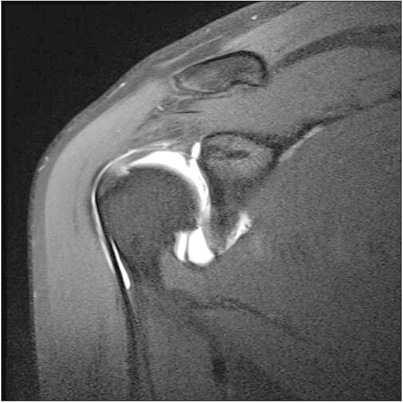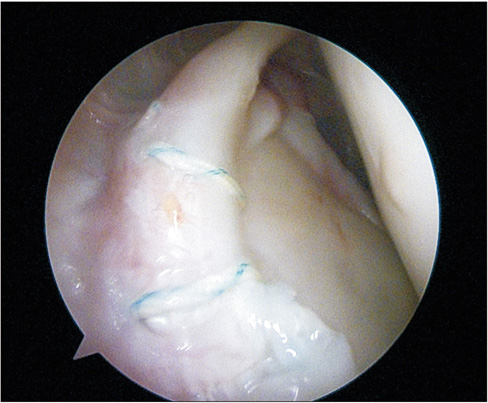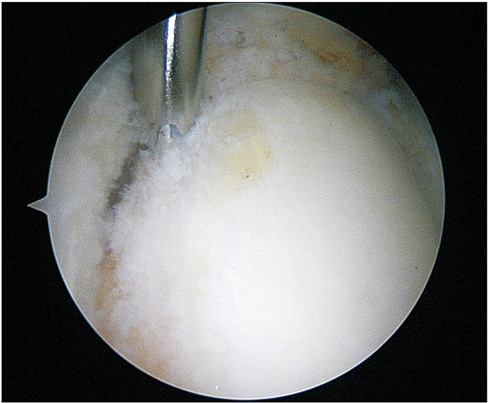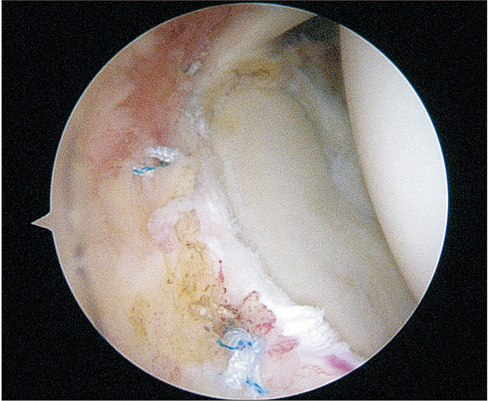J Korean Orthop Assoc.
2017 Oct;52(5):385-391. 10.4055/jkoa.2017.52.5.385.
Problem Solving for Failed Superior Labrum Anterior to Posterior (SLAP) Repair
- Affiliations
-
- 1Center for Shoulder, Elbow and Sports, Neon Orthopaedic Clinic, Seoul, Korea. medos97@naver.com
- KMID: 2393510
- DOI: http://doi.org/10.4055/jkoa.2017.52.5.385
Abstract
- Stiffness and pain are major causes of failed superior labral anterior to posterior (SLAP) repair. The term, "˜failed SLAP repair', can be defined as stiffness or pain without rotator cuff tears, acromio-clavicular pathology, arthritis, impingement syndrome, and other shoulder diseases. Moreover, it does not respond to conservative management. Generally, for failed SLAP repair, the initial conservative management includes physical therapy, strengthening exercise, oral medications, and injections. In addition, with failed conservative treatment, surgical intervention can be carried out. Surgical indications must be in consideration with patients' age, mechanism of injury, stability of the lesion, activity, former history of sports activity, and types of sports. Surgical treatments include debridement, SLAP repair, biceps tenodesis and tenotomy. However, each type of surgical method is controversial on both indications and prognosis. Surgical treatment on SLAP lesion is increasing, and studies on failed SLAP repair are expanding. The recommended first line therapy for failed SLAP lesion is conservative management, and with limited and thorough indications, surgical treatment yields good results, depending on concurrent lesions. However, authors recommend that it is important to seek for adjacent lesions prior to the initial SLAP repair to decrease failed SLAP repair.
Keyword
MeSH Terms
Figure
Reference
-
1. Keener JD, Brophy RH. Superior labral tears of the shoulder: pathogenesis, evaluation, and treatment. J Am Acad Orthop Surg. 2009; 17:627–637.2. Andrews JR, Carson WG Jr, McLeod WD. Glenoid labrum tears related to the long head of the biceps. Am J Sports Med. 1985; 13:337–341.3. Snyder SJ, Karzel RP, Del Pizzo W, Ferkel RD, Friedman MJ. SLAP lesions of the shoulder. Arthroscopy. 1990; 6:274–279.4. Maffet MW, Gartsman GM, Moseley B. Superior labrumbiceps tendon complex lesions of the shoulder. Am J Sports Med. 1995; 23:93–98.5. Powell SE, Nord KD, Ryu RKN. The diagnosis, classification, and treatment of SLAP lesions. Oper Tech Sports Med. 2004; 12:99–110.6. Morgan CD, Burkhart SS, Palmeri M, Gillespie M. Type II SLAP lesions: three subtypes and their relationships to superior instability and rotator cuff tears. Arthroscopy. 1998; 14:553–565.7. Galasso O, Gasparini G, De Benedetto M, Familiari F, Castricini R. Tenotomy versus tenodesis in the treatment of the long head of biceps brachii tendon lesions. BMC Musculoskelet Disord. 2012; 13:205.8. Brockmeier SF, Voos JE, Williams RJ 3rd, et al. Outcomes after arthroscopic repair of type-II SLAP lesions. J Bone Joint Surg Am. 2009; 91:1595–1603.9. Neri BR, Vollmer EA, Kvitne RS. Isolated type II superior labral anterior posterior lesions: age-related outcome of arthroscopic fixation. Am J Sports Med. 2009; 37:937–942.10. Katz LM, Hsu S, Miller SL, et al. Poor outcomes after SLAP repair: descriptive analysis and prognosis. Arthroscopy. 2009; 25:849–855.11. Provencher MT, McCormick F, Dewing C, McIntire S, Solomon D. A prospective analysis of 179 type 2 superior labrum anterior and posterior repairs: outcomes and factors associated with success and failure. Am J Sports Med. 2013; 41:880–886.12. Neuman BJ, Boisvert CB, Reiter B, Lawson K, Ciccotti MG, Cohen SB. Results of arthroscopic repair of type II superior labral anterior posterior lesions in overhead athletes: assessment of return to preinjury playing level and satisfaction. Am J Sports Med. 2011; 39:1883–1888.13. Park JY, Chung SW, Jeon SH, Lee JG, Oh KS. Clinical and radiological outcomes of type 2 superior labral anterior posterior repairs in elite overhead athletes. Am J Sports Med. 2013; 41:1372–1379.14. Abbot AE, Li X, Busconi BD. Arthroscopic treatment of concomitant superior labral anterior posterior (SLAP) lesions and rotator cuff tears in patients over the age of 45 years. Am J Sports Med. 2009; 37:1358–1362.15. Kanatli U, Ozturk BY, Bolukbasi S. Arthroscopic repair of type II superior labrum anterior posterior (SLAP) lesions in patients over the age of 45 years: a prospective study. Arch Orthop Trauma Surg. 2011; 131:1107–1113.16. Weber SC. Surgical management of the failed SLAP repair. Sports Med Arthrosc. 2010; 18:162–166.17. Park MJ, Hsu JE, Harper C, Sennett BJ, Huffman GR. Poly-L/D-lactic acid anchors are associated with reoperation and failure of SLAP repairs. Arthroscopy. 2011; 27:1335–1340.18. Uggen C, Wei A, Glousman RE, et al. Biomechanical comparison of knotless anchor repair versus simple suture repair for type II SLAP lesions. Arthroscopy. 2009; 25:1085–1092.19. Domb BG, Ehteshami JR, Shindle MK, et al. Biomechanical comparison of 3 suture anchor configurations for repair of type II SLAP lesions. Arthroscopy. 2007; 23:135–140.20. Baldini T, Snyder RL, Peacher G, Bach J, McCarty E. Strength of single-versus double-anchor repair of type II SLAP lesions: a cadaveric study. Arthroscopy. 2009; 25:1257–1260.21. Cook C, Beaty S, Kissenberth MJ, Siffri P, Pill SG, Hawkins RJ. Diagnostic accuracy of five orthopedic clinical tests for diagnosis of superior labrum anterior posterior (SLAP) lesions. J Shoulder Elbow Surg. 2012; 21:13–22.22. Pandya NK, Colton A, Webner D, Sennett B, Huffman GR. Physical examination and magnetic resonance imaging in the diagnosis of superior labrum anterior-posterior lesions of the shoulder: a sensitivity analysis. Arthroscopy. 2008; 24:311–317.23. Meserve BB, Cleland JA, Boucher TR. A meta-analysis examining clinical test utility for assessing superior labral anterior posterior lesions. Am J Sports Med. 2009; 37:2252–2258.24. Connolly KP, Schwartzberg RS, Reuss B, Crumbie D Jr, Homan BM. Sensitivity and specificity of noncontrast magnetic resonance imaging reports in the diagnosis of type-II superior labral anterior-posterior lesions in the community setting. J Bone Joint Surg Am. 2013; 95:308–313.25. Amin MF, Youssef AO. The diagnostic value of magnetic resonance arthrography of the shoulder in detection and grading of SLAP lesions: comparison with arthroscopic findings. Eur J Radiol. 2012; 81:2343–2347.26. Park S, Glousman RE. Outcomes of revision arthroscopic type II superior labral anterior posterior repairs. Am J Sports Med. 2011; 39:1290–1294.27. McCormick F, Nwachukwu BU, Solomon D, et al. The efficacy of biceps tenodesis in the treatment of failed superior labral anterior posterior repairs. Am J Sports Med. 2014; 42:820–825.28. Werner BC, Pehlivan HC, Hart JM, et al. Biceps tenodesis is a viable option for salvage of failed SLAP repair. J Shoulder Elbow Surg. 2014; 23:e179–e184.29. Boileau P, Parratte S, Chuinard C, Roussanne Y, Shia D, Bicknell R. Arthroscopic treatment of isolated type II SLAP lesions: biceps tenodesis as an alternative to reinsertion. Am J Sports Med. 2009; 37:929–936.
- Full Text Links
- Actions
-
Cited
- CITED
-
- Close
- Share
- Similar articles
-
- Superior Labrum Anterior to Posterior (SLAP) Lesion with Glenohumeral Instability
- Is There a Clinically Important Superior Labrum Anterior to Posterior (SLAP) Lesion?
- Arthroscopic Treatment of a Type II Superior Labrum Anterior to Posterior (SLAP) Lesion Combined with a Bankart Lesion: Comparative Study between Debridement and Repair of Type II SLAP Lesion by the Status of Lesion
- Anterior Shoulder Instability with Concomitant Superior Labrum from Anterior to Posterior (SLAP) Lesion Compared to Anterior Instability without SLAP Lesion
- Superior Labral Dimension of the Glenohumeral Joint on Direct MR Arthrography (MRA): Relationship with Presence of SLAP (Superior Labrum Anterior to Posterior) Lesion






